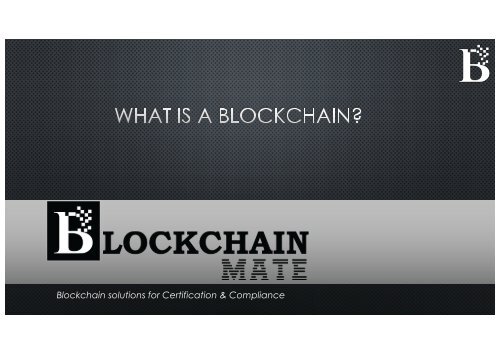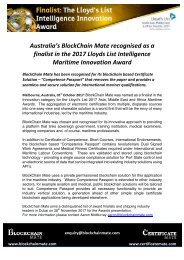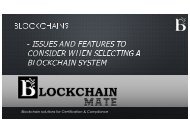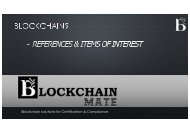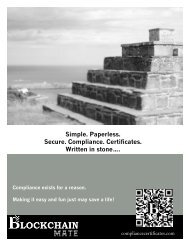Blockchain Introduction by BlockChain Mate
Create successful ePaper yourself
Turn your PDF publications into a flip-book with our unique Google optimized e-Paper software.
<strong>Blockchain</strong> solutions for Certification & Compliance
<strong>BlockChain</strong> <strong>Mate</strong> create solutions to<br />
remove paper and frustration from the<br />
certification and compliance universe.<br />
We also workshop, collaborate, and<br />
develop blockchain products ….
Simple answer: A DATABASE
More complicated answer:<br />
1: Apeer-to-peer network 2: A blockchain file<br />
PEER<br />
PEER<br />
PEER<br />
PEER<br />
Block 1 Block 2 Block 3 Block 4 Block 5<br />
PEER<br />
PEER<br />
3: An agreed set of protocols 4: A blockchain parser<br />
sha256(sha256(block)) < difficulty<br />
Block 1 Block 2 Block 3 Block 4
1960s: IBM introduces hierarchical databases (moonshot).<br />
1970: Edgar Frank Codd, working at IBM, publishes the<br />
Relational Database Model. IBM sticks with the hierarchical<br />
model (RDBM too slow...).<br />
1979: Oracle releases the first commercial RDMS. SQL starts to<br />
become popular. Oracle becomes rich.<br />
2008: Nakamoto publishes “Bitcoin: A Peer-to-Peer Electronic<br />
Cash System”<br />
2016: Most databases are RDMS. Oracle, MySQL, Microsoft<br />
SQL Server, PostgreSQL and IBM DB2 are the most popular<br />
implementations.
In the early 80s there were cases where a<br />
computer database salesperson would<br />
approach a company to encourage them to<br />
purchase and install one, only to be told:<br />
“I have a perfectly good filing cabinet and<br />
secretary. Why do I need a database?”
●<br />
Records can be altered without a trace if incorrectly<br />
configured, or <strong>by</strong> a skilled administrator.<br />
●<br />
Centralized <strong>by</strong> design, relying on client/server model.<br />
●<br />
Problems with backups, synchronization across multiple<br />
database centers, concurrent record editing, and so on.<br />
(Credit:<br />
http://xkcd.com)
●<br />
A method of storing data in a sequential chain of blocks.<br />
●<br />
Each block is a package of data created within a short<br />
consecutive window of time.<br />
●<br />
A block has its own “hash”, based on the data it<br />
contains, which is like a fingerprint that uniquely<br />
identifies it.
●<br />
Each block (except the first “genesis block”) contains a<br />
reference to the block before it using the previous<br />
block’s hash, there<strong>by</strong> forming a chain.<br />
Block B1 Block B2 Block B3 Block B4<br />
hash(B1) hash(B2) hash(B3)<br />
●<br />
The earlier blocks in the chain cannot be tampered with,<br />
because changing a block changes its hash, and this<br />
would break the chain of references.
●<br />
Some of the devices on a peer-to-peer network<br />
regularly transmit data onto the network, to be included<br />
in the next block.<br />
●<br />
Other devices receive and package the data into their<br />
own proposed block and then hold a lottery (consensus<br />
system) to see which device was lucky enough to<br />
create the block to be included.<br />
●<br />
They do this because there is a reward for creating the<br />
next new block, or because they are run <strong>by</strong> entities who<br />
value the availability of the blockchain.
●<br />
The lottery odds are adjusted occasionally to ensure<br />
that new blocks are accepted at roughly the same<br />
regular interval, for example every ten minutes or so.<br />
●<br />
The most popular lottery methods are called:<br />
“proof-of-work” (used <strong>by</strong> Bitcoin)<br />
“proof-of-stake” (proposed for Ethereum)<br />
“practical Byzantine fault tolerance” (Hyperledger Fabric)<br />
“proof of elapsed time” (Hyperledger Sawtooth Lake)
Type Description Example Use<br />
Public<br />
The blockchain is available<br />
freely on the internet. Software<br />
is generally open source or<br />
freely downloadable. Protocol<br />
specifics are usually published.<br />
• Bitcoin<br />
• Public parking billing system<br />
• Global share trading platform<br />
• “Passport” system<br />
• Review/reputation system<br />
Permissioned<br />
Private<br />
The blockchain is accessed on<br />
the internet, but software is<br />
usually proprietary, and access<br />
is through keys issued <strong>by</strong> an<br />
authority.<br />
The blockchain is only available<br />
on an intranet/VPN, and access<br />
is through keys issued <strong>by</strong> an<br />
authority<br />
• Asset tracking <strong>by</strong> consortium<br />
of shipping companies<br />
• Smart meters run <strong>by</strong> power<br />
company with multiple<br />
billing/admin companies<br />
• Location based game<br />
• In-house notarizing of<br />
invention disclosures <strong>by</strong> R&D<br />
department<br />
• HR permanent records<br />
• Legal compliance records
Integrity<br />
of data<br />
records<br />
<strong>Blockchain</strong><br />
Records on the chain cannot<br />
be altered without an<br />
impossibly large amount of<br />
computing power<br />
Database<br />
Records can be deleted<br />
or altered, and if logs<br />
are edited the changes<br />
cannot be detected<br />
Audit<br />
trail<br />
All actions are visible on the<br />
blockchain (although<br />
individual data within records<br />
may be encrypted)<br />
Location Stored in a distributed<br />
system across many (low<br />
powered) machines<br />
Only administrators of<br />
the central system can<br />
view actions taken, and<br />
even then the logs may<br />
have been invisibly<br />
altered<br />
Stored on a high power<br />
central server (possibly<br />
with secondary backup<br />
servers)
Speed<br />
Participants<br />
Trust<br />
<strong>Blockchain</strong><br />
Records can take minutes to<br />
be added to the system.<br />
Future systems may make<br />
millisecond blocks feasible.<br />
A network of peers<br />
Arises naturally between<br />
participants due to the<br />
actions required to add<br />
records and the rewards<br />
obtained for doing so<br />
Database<br />
Records are added in<br />
milliseconds<br />
A central authority<br />
granting or denying<br />
access to clients<br />
At a subjective level<br />
based on the perceived<br />
reliability of the<br />
database owner. Relies<br />
on a company’s<br />
reputation
History<br />
<strong>Blockchain</strong><br />
First emerged in 2009, new<br />
technology that is still evolving<br />
and developing. Need<br />
improvements in ease of use<br />
and ability to integrate.<br />
Database<br />
Relational databases<br />
were proposed in 1970,<br />
and have been<br />
developed extensively<br />
ever since<br />
Cost<br />
Require custom development<br />
or integration.<br />
Free high quality<br />
databases are available,<br />
but commercial ones for<br />
niche purposes can be<br />
expensive to use (eg<br />
SAP)
Hardware<br />
Charging<br />
model<br />
Collaboration<br />
<strong>Blockchain</strong><br />
Easily scalable <strong>by</strong> adding<br />
new peers. Initial networks<br />
can be launched with cheap<br />
low power devices, and<br />
extended on an ad-hoc<br />
basis as more devices join<br />
Folded-in due to<br />
cryptocurrency history<br />
Emerges naturally from<br />
intrinsic design<br />
Database<br />
Cheap for simple lowuser<br />
applications,<br />
expensive servers and<br />
support staff required<br />
for large user bases<br />
Requires integration<br />
and customisation<br />
Requires extensive<br />
access rights<br />
configuration, and is<br />
vulnerable to hacking
<strong>BlockChain</strong> <strong>Mate</strong> – About Us<br />
Adam Crook – Cofounder and Technical Lead<br />
Adam holds a Bachelor of Computer<br />
Science and a MBA. Adam is a specialist<br />
in leading project teams in complex<br />
technology environments and has been<br />
involved in leading successful technology<br />
deployment in his current role and for<br />
other large companies including ANZ and<br />
Telstra. Adam has significant expertise in knowledge and<br />
information management, and security requirements. Adam is<br />
a blockchain subject matter expert, and will provide the<br />
technical oversight and product architect role to this project.<br />
Aaron McMurray– Cofounder and Commercial Lead<br />
Aaron holds a Bachelor of Science and<br />
a MBA and is an experienced Business<br />
Strategy Professional who has<br />
experience with a number of<br />
companies in Australia and Europe.<br />
Aaron has a vast “knowledge bank” -<br />
from a varied professional background –<br />
in maritime operations and corporate<br />
experience in Business Strategy and Strategic Marketing in<br />
Europe and Australia. Aaron is able to quickly identify<br />
opportunities for value creation – especially strategic<br />
positioning to maximise opportunities with new technology.<br />
We know blockchain.<br />
We know technology deployment.


